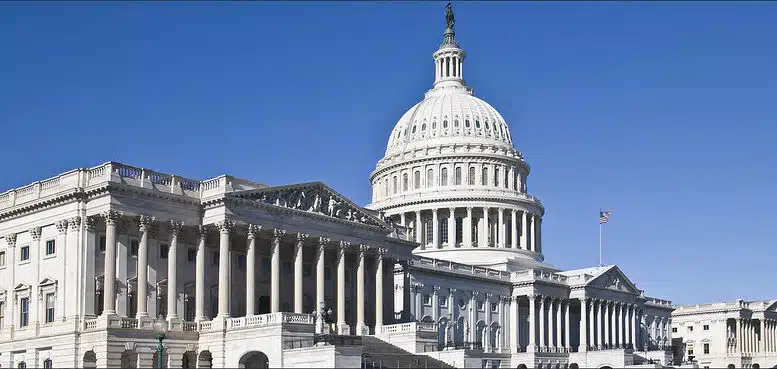By Will Atwater
In May, when a U.S. Supreme Court decision changed the rules on which wetlands can be protected by federal law, the news ripped through the environmental community like a tornado. Just weeks later, environmentalists in North Carolina were rocked again when the state legislature aligned itself with the high court decision, stripping protections from millions of acres of wetlands in the state.
That one-two punch propelled Sherri White-Williamson to Washington, D.C.
White-Williamson, an environmental activist from southeastern North Carolina, traveled with eight other educators, researchers and environmental advocates to talk to members of Congress and strategize about how to push back in the wake of the Supreme Court’s ruling in Sackett v. EPA.
She remembers hoping that her outward calm would conceal her nerves as she worked toward her goal of informing Congressional leaders about the vital role of wetlands — even ones that are only wet for parts of the year and that aren’t visibly attached to any navigable rivers or streams — to agricultural communities.
The 5-4 Supreme Court decision gutted decades of work by White-Williamson and myriad others to protect an estimated 2.5 million acres of vital wetlands in North Carolina that are not adjacent to navigable rivers and lakes. These North Carolina wetlands are often crucial in helping preserve clean drinking water, mitigate flooding and sequester carbon dioxide, a greenhouse gas.
Activists denounced the high court’s ruling, saying that a loss of protections for intermittent wetlands threatens to erase decades of environmental progress gained under the Clean Water Act.
Now the environmental activists have decided to fight. The first step was that meeting in
Washington, where they chewed through the ruling and its potential implications. To them, it was the first attempt to bring people together and mount a response to the court’s decision, to claw back some of the protections that they see on the chopping block.
National effects, state effects
U.S. Rep. Grace Napolitano (D-California) summoned White-Williamson and her colleagues to strategize a response to this new “post-Sackett world.”
“We cannot rely on state governments to prioritize the protection of these important resources,” White-Williamson told the group. “In fact, our state has already taken action that puts North Carolina wetlands in harm’s way. A provision of the North Carolina Farm Act of 2023 strips protection for at least half of North Carolina’s wetlands.”
That Farm Act, which North Carolina lawmakers pushed through a month after the high court’s decision, would allow wetlands that cover an area more than twice the size of Rhode Island to lose “Waters of the United States” designation, which had protected them from actions like being paved over during a construction project.
Gov. Roy Cooper vetoed the bill, but the legislature easily overrode that veto on June 27.
Cooper’s veto statement decried the weakened protections for these wetlands. He said the Farm Bill “means more severe flooding for homes, roads and businesses and dirtier water for our people, particularly in eastern North Carolina.”
Arriving at this moment
In 1972, the Clean Water Act evolved from the 1948 Federal Water Pollution Control Act, which attempted to clean up the nation’s waterways. The Clean Water Act regulates “navigable waters” such as oceans, large lakes and rivers, also known as “Waters of the United States.”
These bodies are regulated by the Army Corps of Engineers and the Environmental Protection Agency.
Before the Sackett ruling, wetlands adjacent to navigable waters received protection under the Clean Water Act. In the Sackett decision, though, the Supreme Court ruled that for wetlands to receive any federal protection, they must have a continuous connection to those navigable waters.
That rules out areas that aren’t connected to flowing waters: shallow ponds that only fill after spring rains and marshes that dry up in late summer.
In response, the EPA announced that its agency and the corps would align their interpretation of navigable water with the Supreme Court’s ruling.
These proposed changes to the definition of navigable waters have sent environmentalists and advocacy agencies scrambling to figure out how the changes could impact communities across the country.
“In an apparent effort to serve their own conservative theology, five members of our Supreme Court decided to ignore the law, ignore the science, [and] ignore over 50 years of success in protecting clean water in the Sackett decision,” Napolitano said in her opening remarks.
Stakes are high
North Carolina wetlands are only part of the picture. The Sackett ruling altered the wetland security landscape when it comes to wetland security across the country, where the loss of protections for certain wetlands could have multiple effects.
U.S. Rep. Rick Larsen (D-Washington) reiterated the potential widespread environmental harm that could occur due to the Supreme Court’s ruling. Larsen lamented that changes to how navigable waters are defined “could threaten roughly 50 percent of wetlands and 70 percent of rivers and streams protected since the creation of the Clean Water Act.”
“We can expect increased flooding when formerly protected wetlands are filled in or polluted,” Larsen said. “Flooding upstream of ephemeral or intermittent streams will likely lead to water body pollution downstream. Pollution can mean … beach closures, harmful algae blooms and habitat destruction to plants and animals that rely on those waters. These kinds of harmful impacts will effectively reverse investments that we’ve been making for decades.”
Betsy Southerland, former EPA administrator and current member of the Environmental Protection Network, an organization of former EPA staffers whose mission is to generate bipartisan support for the environment, doubled down on the potential environmental impacts due to a weaker CWA.
“Unless Congress amends the Clean Water Act to spell out a detailed definition of Waters of the US based on the proven science of hydrologic connectivity,” Southerland said, “the Clean Water Act’s goal of restoring and maintaining the chemical, physical and biological integrity of the nation’s waters will literally be impossible to achieve.”
Unintended consequences
The Republican-led North Carolina legislature has aligned its interpretation of navigable waters with the Supreme’s Court ruling in the Sackett case. Critics argue that’s a win for land developers and contractors.
Roundtable participants discussed new challenges that will fall on states.
Kira Davis introduced herself as “a tribal citizen of the Grand Traverse band of Ottawa and Chippewa Indians, a federally recognized Great Lakes tribe and signatory of the 1836 Treaty of Washington.” She is also the Great Lakes program manager for the National Parks Conservation Association, which she said works to “protect and preserve the national parks system for future generations.”
Davis said changes to the Clean Water Act will put more of a burden on tribal communities to maintain water quality standards in their communities, which many are ill-equipped to do.
“This ruling leaves tribes that don’t have authority over specific federal regulatory programs without protections to the very waters that tie them to their cultural identity and traditions.”
White-Williamson echoed Davis’ concerns about the additional burdens the Sackett decision will place on tribal communities.
Sign up for our Newsletter
“*” indicates required fields
“North Carolina has a number of tribes, but only one is federally recognized,” she said. “We have tribes that can’t benefit from some of the federal regulations that should be available to all of the tribes …[These] are some of the things from an environmental justice perspective, I think the committee needs to consider as they’re looking at the Sackett decision and how to address it.”
White-Williamson also spoke about how reduced protections for wetlands will negatively affect people living in southeastern North Carolina, many of whom live in flood-prone areas and get their drinking water from wells. She mentioned how the region continues to battle environmental issues related to the abundance of hog lagoons in the region, with some lagoons located in the floodplain.
“We’ve had two 500-year storms — one in 2016, one in 2018. And had it not been for the wetlands, there would have been much more destruction in those areas: homes destroyed, businesses destroyed and those kinds of things,” said White-Williamson, alluding to hurricanes Matthew and Florence. The two storms combined resulted in billions of dollars in damages and deaths to humans and to commercially raised hogs and poultry.
Marching orders
While many potential environmental harms lurk in the background of a post-Sackett world, the panel did offer advice about things policymakers and their constituents should consider to mitigate future fallout.
James McElfish, a lawyer at the Environmental Law Institute, a public policy research and think tank, noted the “patchwork of inconsistent protections across the United States.”
He said the federal government should look to support and encourage state permitting programs that focus on non-navigable waters “important to the hydrologic function, or the health of traditionally navigable waters … as a stopgap measure.”
U.S. Rep. Melanie Stansbury (D-New Mexico) gave attendees their marching orders as the meeting ended.
“It is well within our purview to fix this statutorily and for the American people to demand that we have clean water,” she said. “As politicos, we are only as good as the people we stand arm in arm and side by side with. We need you to organize, educate and help the American people understand how significant this decision is and why we need Congress to act now.”
Arizona State University’s Rhett Larson, Richard Morrison Professor of Water Law, said that the nature of water policy is to draw lines of demarcation. However, “the nature of water is to defy lines,” he said.
“Fifty years after his passing, I would encourage all of us to embrace the martial arts philosophy of Bruce Lee, who said ‘Be water,’” he said.
“If we are to effectively manage water, we have to be more like water and be as adaptive as the resource we are seeking to protect.”










